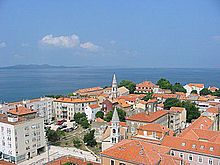
Back Dalmatští Italové Czech Dálmatas italianos Spanish Dalmatinski Talijani Croatian Dalmati italiani Italian ダルマチア・イタリア人 Japanese Итальянцы в Далмации Russian Dalmatian Italians SIMPLE
 Overview of Zara (now Zadar in Croatian Dalmatia), where Dalmatian Italians are about 0.13% of the population.[1] In 1921, before the Istrian–Dalmatian exodus, the Dalmatian Italians were 70% of the city's population.[2] | |
| Regions with significant populations | |
| Dalmatia, former Venetian Albania, Italy | |
| Languages | |
| Primarily Italian and Croatian, Venetian, formerly Dalmatian | |
| Religion | |
| Roman Catholic | |
| Related ethnic groups | |
| Istrian Italians, Croats, Italians |
Dalmatian Italians (Italian: dalmati italiani; Croatian: Dalmatinski Talijani) are the historical Italian national minority living in the region of Dalmatia, now part of Croatia and Montenegro.
In 1803, the Italian community accounted for 33% of the entire Dalmatian population,[3][4] a number that dropped to 20% in 1840, to 12.5% in 1865, to 5.8% in 1880 and to 2.7% in 1910,[5] suffering from a constant trend of decreasing presence[6] and now, as a result of the Istrian–Dalmatian exodus (1943–1960), numbers only around 500–2,000 people (0.05%–0.2%).[1][7][8][9] Throughout history Dalmatian Italians exerted a vast and significant influence on Dalmatia, especially cultural and architectural.
They are currently represented in Croatia and Montenegro by the Italian National Community (Italian: Comunità Nazionale Italiana) (CNI). The Italo-Croatian minorities treaty recognizes the Italian Union (Unione Italiana) as the political party officially representing the CNI in Croatia.[10]
The Italian Union represents the 30,000 ethnic Italians of former Yugoslavia, living mainly in Istria and in the city of Rijeka (Fiume). Following the positive trend observed during the last decade (i.e., after the dissolution of Yugoslavia), the number of Dalmatian Italians in Croatia adhering to the CNI has risen to around one thousand. In Dalmatia the main operating centers of the CNI are in Split, Zadar, and Kotor.[11]
- ^ a b Cite error: The named reference
census2011was invoked but never defined (see the help page). - ^ Ministero dell'economia nazionale, Direzione generale della statistica, Ufficio del censimento, Censimento della popolazione del Regno d'Italia al 1º dicembre 1921, vol. III Venezia Giulia, Provveditorato generale dello Stato, Rome, 1926, pp. 192-208 (In Italian)
- ^ Cite error: The named reference
Bartoliwas invoked but never defined (see the help page). - ^ Cite error: The named reference
Seton-Watsonwas invoked but never defined (see the help page). - ^ Cite error: The named reference
Peričićwas invoked but never defined (see the help page). - ^ For example in the Austrian Census of 1857 the Dalmatian Italians were only 45,000 -or nearly 15% of the Dalmatia without the Quarner islands (read [1]
- ^ Cite error: The named reference
monstatwas invoked but never defined (see the help page). - ^ Cite error: The named reference
coordinamentoadriaticowas invoked but never defined (see the help page). - ^ Cite error: The named reference
comunitaitalianawas invoked but never defined (see the help page). - ^ "Comunità Nazionale Italiana, Unione Italiana". Unione-italiana.hr. Retrieved 8 February 2016.
- ^ "Le Comunità degli Italiani". Archived from the original on 4 May 2010. Retrieved 18 November 2010.
© MMXXIII Rich X Search. We shall prevail. All rights reserved. Rich X Search